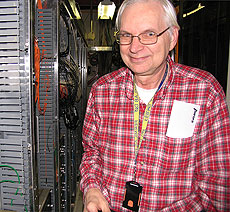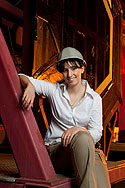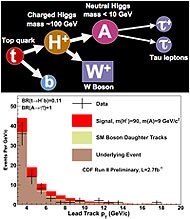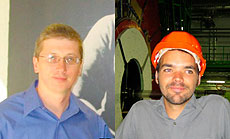|
For information about H1N1, visit Fermilab's flu information site.
|
|
Thursday, Feb. 3
- Breakfast: Apple sticks
- Santa Fe black bean soup
- Steak tacos
- Chicken Wellington
- Chimichangas
- Baked ham & Swiss on a ciabatta roll
- Assorted sliced pizza
- Crispy fried chicken salad
Wilson Hall Cafe Menu |
|
Thursday, Feb. 4
Dinner
- Shrimp cocktail
- Glazed filet mignon with bourbon-roquefort sauce
- Two-potato cake
- Steamed green beans
- Poached pears with chocolate pear sauce
Wednesday, Feb. 10
Lunch
- Mahogany beef stew w/red wine & hoisin sauce
- Horseradish mashed potatoes
- Baked apples
Chez Leon Menu
Call x3524 to make your reservation.
|
|
|
After almost four decades, John Foglesong says farewell
 |
| John Foglesong shows off some of his handiwork inside DZero's moveable counting house. |
John Foglesong is a creature of exacting habits. It's a quality well known around DZero, where the lanky electrical engineer has spent 21 of the 38 years he's worked at Fermilab.
All business, Foglesong can rattle off minute details of almost every project he's ever touched. But a moment later he breaks into a toothy grin as he points out the political cartoons and jokes that paper his office walls.
"LAST DAY" is written in red marker on Friday, Feb. 5, on his calendar.
Just down the hall, Mike Matulik, Foglesong's supervisor at the PPD EED infrastructure group, says both Foglesongs will be missed-the man with the visible funny bone, and the man with razor-sharp focus.
"He is very determined. When you give John a project, he digs until he gets all the information he needs," Matulik said.
Foglesong started at Fermilab on Feb. 7, 1972, fresh out of a six-year stint in the Navy, as an electrical technician in the laboratory's now defunct bubble chamber.
"We basically baby-sat the thing," he said; but a bubble chamber is no easy charge.
"We had everything there," he said. "Cryogenics, high-pressure oil, moving pistons.
You really had to know what you were doing."
In those days, Foglesong spent his evenings doggedly pursuing an electrical engineering degree. It took him nine years, but he graduated from IIT in 1983.
When the bubble chamber closed, Foglesong moved over to DZero. After 21 years, he's headed up countless operations, but one of his proudest accomplishments was helping redesign the power distribution, interlock, and cabling systems for a major portion of the experiment's trigger system.
After three years of phased retirement, things won't change too drastically come Friday. Foglesong is looking forward to seeing more of his wife, though. And his new pontoon boat.
Come celebrate John Foglesong's career today at 11:30 a.m. at Pal Joey's, 440 E. Roosevelt, West Chicago. Please contact Carolyn Johnson x4206 or Julie Saviano x4591.
-- Andrea Mustain
|
Underground with
Aria Meyhoefer
 |
| Aria Meyhoefer |
Aria Meyhoefer feels comfortable underground. The medium-height brunette dons a hard hat, shuts the large elevator door and begins the slow descent to a cavern 330 feet below the surface. It is this below-ground area of MINOS, a detector that measures beams of neutrinos before it sends them through the earth to a second detector in Minnesota, that Meyhoefer helps to keep running smoothly.
Last year, after spending seven years as a Main Control Room operator, she took on two new roles: the Meson Test Beam assistant manager and the MINOS underground coordinator. At the Meson Test Beam Facility, Meyhoefer manages the day-to-day operations, including directing questions about testing experiments, managing the Web site and scheduling access to the test beam.
At MINOS, she helps coordinate access to the underground area, advises people on the training they need, schedules tours, and tracks underground activities in an electronic log book. Now, for example, MINERvA is going into the hall; ArgoNeuT is coming out; and COUPP experimenters are switching their experiment around.
"Someone has to be aware of what everyone is doing underground at all times," Meyhoefer said. "Safety of people underground is our highest priority."
While employees or users can contact Meyhoefer with any questions about access to the MINOS Underground Area, information about access is available below:
- Any employee or user interested in touring the MINOS near-detector hall can request a tour. Learn more.
- No one can be underground alone.
- Anyone needing to access the underground area without a tour must have NuMI underground training and GERT or Rad-worker training. After filling out a request form, employees and users can give tours to groups of two people who received a safety briefing.
- In all cases, to conduct work underground, employees and users must fill out a work permit.
- Any qualified employee making a visual inspection is allowed to do so without a work permit or tour number as long as they are not doing work of any kind.
|
Europe's LHC to run at half-energy, tightening race for Higgs
From Science Insider, Feb. 2, 2010
The world's highest energy atom smasher, the Large Hadron Collider (LHC), will run at half its maximum energy through 2011 and likely not at all in 2012. Officials at the European particle physics laboratory, CERN, had previously planned to run the gargantuan accelerator at 70 percent of maximum energy this year.
The change raises hopes at the LHC's lower-energy rival, the Tevatron Collider at Fermi National Accelerator Laboratory (Fermilab) in Batavia, Illinois, of being extended through 2012 instead of being shut down next year. Fermilab researchers are hoping that their machine might collect enough data to beat the LHC to the discovery of the long-sought Higgs boson, a particle key to how physicists explain the origin of mass.
The $5.5 billion LHC is designed to blast protons into other protons at an energy of 14 trillion electron-volts (TeV), seven times the Tevatron's maximum. But it cannot run at full energy because of a few faulty electrical connections, or "interconnects," between the thousands of superconducting magnets that guide particles around the 27-kilometer subterranean ring. In September 2008, just 9 days after it first circulated particles, the LHC suffered a catastrophic breakdown when an interconnect between two magnets melted. That problem took 14 months to correct. The previous plan was to run the LHC briefly at 7 TeV, stop for a few months to rework the weakest interconnects, then ramp up 10 TeV later this year. CERN officials have now scaled back the energy to 7 TeV for this year and next, says Steve Myers, director of accelerators and technology at CERN.
Read more
|
|
|
Using top quarks to search for Higgs bosons
 |
| Top figure: A cartoon of how top quarks may decay through Higgs bosons. Bottom figure: Transverse momentum of isolated tracks in candidate top quark events, with the excluded level from the Higgs boson (denoted A) in red. |
Many people don't understand why the Higgs boson is so hard to find. CDF scientists suggested that perhaps scientists have been looking for the elusive particle in the wrong place.
So, CDF scientists tried a new approach and recently looked for Higgs bosons produced in the decay of top quarks, something predicted by the next-to-minimal supersymmetric model. This popular extension of the Standard Model predicts additional bosons; an electrically charged Higgs, the H±; and a potentially very light (less than twice the b-quark mass) electrically neutral Higgs, denoted A.
Motivated by an excess seen in previous experimental data from LEP and input from theorists, CDF researchers looked at the possibility that top quarks might not always decay into a W± boson and a b quark as they expect in the Standard Model. Instead, top quarks may sometimes decay through these new Higgs bosons (the H± and the A), as shown in the cartoon above. The tau leptons from the decay of the A would show up in the detector as isolated tracks, but the leptons have such low energy that they would not be identified in standard analyses using top quarks.
So, in order to search for these strange events, CDF researchers selected top quark events with additional low-energy isolated tracks. The dominant background for this search comes from tracks originating from low-energy interactions. These types of background events are poorly modeled by simulations, prompting researchers to design a new data-based approach to model backgrounds for this untested region.
In the end, no evidence of signal was seen. Using this null result, the CDF scientists were able to set the first limits on models that include this type of top quark decay.
Learn more about this analysis
--Edited by Craig Group
 |
| These scientists contributed to this analysis. From left: Andrew Ivanov, Kansas State; Will Johnson, UC Davis.
|
|
Ancient dawn's early light refines age of universe
From Science News, Feb. 2, 2010
Satellite images reveal new aspects of Big Bang's relic radiation
Six papers posted online present new satellite snapshots of the earliest light in the universe. By analyzing these images, cosmologists have made the most accurate determination of the age of the cosmos, have directly detected primordial helium gas for the first time and have discovered a key signature of inflation, the leading model of how the cosmos came to be.
The analysis, based on the first seven years of data taken by NASA's Wilkinson Microwave Anisotropy Probe, also provides new evidence that the mysterious entity revving up the expansion of the universe resembles Einstein's cosmological constant, a factor he inserted but later removed from his theory of general relativity. In addition, the data reveal that theorists don't have the right model to explain the hot gas that surrounds massive clusters of galaxies.
Read more
|
|



